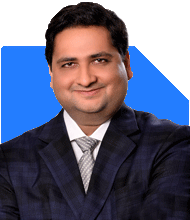Hardik Parikh | Answer |Ask -Follow
Tax, Mutual Fund Expert - Answered on Aug 31, 2023
He also holds an MBA degree from IIM-Indore.
Hardik, who began his career as an equity research analyst, founded his own advisory firm, Hardik Parikh Associates LLP, which provides a variety of financial services to clients.
He is committed to sharing his knowledge and helping others learn more about finance. He also speaks about valuation at different forums, such as study groups of the Western India Regional Council of Chartered Accountants.... more

I have not withdrawn my PF amount from my previous company (PF deposited in trust) for the last 5 years. do I am getting interest on that?
Certainly! If you haven't withdrawn your Provident Fund (PF) amount from your previous company where the PF was deposited in a trust, you should be aware of the following:
1. Interest Accrual: As per the information available, if no contribution is received into a PF account for 3 consecutive years, the account will not earn any interest after those 3 years. This means that if your PF account has been inactive (no contributions) for the last 5 years, it would have earned interest only for the first 3 years out of those 5 years.
2. Tax Implications: If an employee has rendered continuous service for a period of five years or more, the accumulated EPF balance is exempt from tax. However, if you decide to withdraw the amount before completing 5 years of continuous service, there might be tax implications.
3. Recommendation: It's always a good idea to periodically check your PF account to ensure that it's earning interest and to be aware of any changes in rules or regulations. If you're unsure about the status of your PF account, you might want to contact the trust where your PF is deposited or consult with a financial advisor.
I hope this helps!
You may like to see similar questions and answers below
Mihir Tanna |1089 Answers |Ask -Follow
Tax Expert - Answered on Sep 09, 2022
Vipul Bhavsar | Answer |Ask -Follow
Tax Expert - Answered on May 15, 2025
Ulhas Joshi |280 Answers |Ask -Follow
Mutual Fund Expert - Answered on Dec 05, 2025
Dr Dipankar Dutta |1835 Answers |Ask -Follow
Tech Careers and Skill Development Expert - Answered on Dec 04, 2025
Ravi Mittal |676 Answers |Ask -Follow
Dating, Relationships Expert - Answered on Dec 04, 2025
Anu Krishna |1745 Answers |Ask -Follow
Relationships Expert, Mind Coach - Answered on Dec 04, 2025
Anu Krishna |1745 Answers |Ask -Follow
Relationships Expert, Mind Coach - Answered on Dec 04, 2025
Mayank Chandel |2562 Answers |Ask -Follow
IIT-JEE, NEET-UG, SAT, CLAT, CA, CS Exam Expert - Answered on Dec 04, 2025
Mayank Chandel |2562 Answers |Ask -Follow
IIT-JEE, NEET-UG, SAT, CLAT, CA, CS Exam Expert - Answered on Dec 04, 2025
Mayank Chandel |2562 Answers |Ask -Follow
IIT-JEE, NEET-UG, SAT, CLAT, CA, CS Exam Expert - Answered on Dec 04, 2025
Mayank Chandel |2562 Answers |Ask -Follow
IIT-JEE, NEET-UG, SAT, CLAT, CA, CS Exam Expert - Answered on Dec 04, 2025
Mayank Chandel |2562 Answers |Ask -Follow
IIT-JEE, NEET-UG, SAT, CLAT, CA, CS Exam Expert - Answered on Dec 04, 2025

























